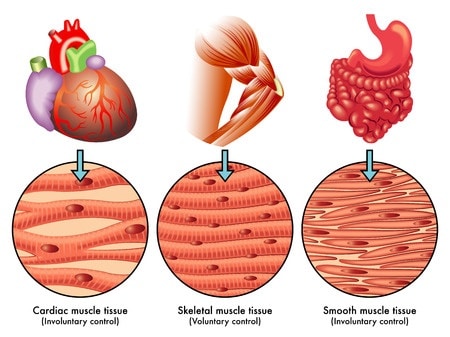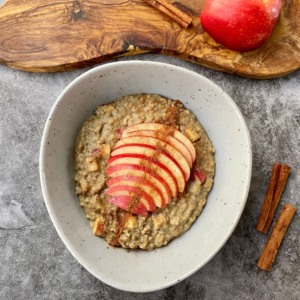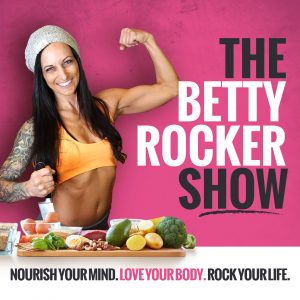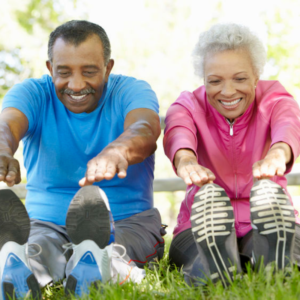
In this post:
- I. Why muscle matters
- II. How muscle impacts your body composition
- III. What is your muscle made up of?
- IV. How muscle tissue gets energy to move
- V. How muscle is gained (and lost) through exercise
- VI. How your muscle uses the food you eat for energy and growth
- VII. Hormones and factors that play a key role in muscle growth
- VIII. Muscle through our lifespan
- IX. Training on a strong foundation and keeping your muscles balanced and strong
I. Why Muscle Matters
How we move, look and feel is all directly related to healthy muscle tissue. Your muscle powers every move you make, from walking to talking to standing upright. Maintaining strong, healthy and balanced muscle tissue as you go through time will increase your quality of life.
Muscle helps you with daily activities like carrying your groceries, walking up and down stairs, and picking up kids and pets. It protects your organs, surrounds and stabilizes your joints, and is what gives your body shape, “tightness” and strength.

Your muscle tissue is highly concentrated with mitochondria, the cellular organelles responsible for ATP (energy) production. Staying active and exercising regularly helps keep muscle tissue healthy by increasing mitochondrial density.
Muscle tissue has also been identified as an endocrine organ (1), meaning it’s a player in the chemical messenger system the body uses to send signals that regulate our health. Contracting muscle secretes (produces) peptides and cytokines (chemical messengers) as part of a hormone signaling network which communicate with other organs and support healthy immune function, insulin response and increased metabolic health. (2,3,4)
You can improve the quality of your muscle tissue in so many ways – from stretching and mobility exercise like yoga, to cardiovascular exercise (both aerobic and anaerobic), resistance training with your own body weight against gravity, and using weights, bands and machines.
Variety and consistency are the name of the game when it comes to using your muscle and keeping it supple and strong throughout your life.
II. How muscle impacts your body composition

I know it may not be on your radar to focus on muscle gain over fat loss because we’ve been so trained by diet culture to think about our “body fat” as the primary needle mover, but I want to reframe that viewpoint, and break down some important things you need to know about what muscle does, how it works, and how important it really is to preserve as you go through your life as a strong, capable and healthy woman.
Body composition is often overlooked in “weight loss” focused training. Five pounds of muscle and five pounds of fat both weigh five pounds, but they take up very different amounts of space in our bodies (see picture below). Fat is looser and takes up more space per pound than muscle, which is dense and compact.

As you add muscle to your body, not only do you become a more efficient fat burner (as muscle burns more calories due to the increased energy output when a muscle contracts) but you also change the shape (composition) of your body – usually to an aesthetically tighter, more “toned” shape.
This doesn’t always translate to the amount of “weight” lost – if you were to replace a pound of fat on your body with a pound of muscle, you would not change your “weight” but the composition and shape of your body would change to look smaller and you’d be reaping all the benefits of carrying that additional muscle tissue.
Losing fat without strengthening and growing muscle may make the body appear smaller, but looser. While I dislike the term “skinny-fat” this accurately describes the flabby state of a non-muscular body.
People who focus on excessive cardio and dieting (without any focus on strength training) can experience negative results, including a lowered immune response and an increased stress response – which contributes to muscle breakdown, and slows fat loss.
When weight loss is your goal, consider adjusting your frame to include “muscle acquisition” as a shared goal with fat loss.
If adding or improving the quality of our muscle is already a goal, we can directly impact fat loss in similar ways as we impact muscle strength – with mobility and flexibility work, resistance training, cardiovascular training, healthy eating, regular rest and good sleep, and mitigating our stress levels.
III. What is your muscle made up of?

Of the three types, only skeletal muscle is under our voluntary control – fortunately the other two types work without us having to think about them consciously!
Muscle gets its ‘stretchiness’ from thousands of fibers that make it up. Whether you are running, walking or talking, movement happens when these muscle fibers contract.
There are two main types of muscle fiber, slow twitch and fast twitch.
- Slow twitch muscle fibers (also called Type 1) are focused on sustained, smaller movement and posture control. They are more resistant to fatigue, and are well suited to support longer, more endurance type activities. They are aerobic in nature (they rely on oxygen). They have been shown to hypertrophy (increase muscle mass) with progressive overload and with aerobic exercise as well.
- Fast twitch muscle fibers (also called Type 2) are more focused on bigger, more powerful movement but for shorter durations, and fatigue more quickly. Type 2a uses a combination of aerobic and anaerobic metabolism to create energy, where type 2b uses anaerobic metabolism (without oxygen) alone.
You may be born with more of one than another fiber type, making you naturally more capable of excelling in a certain type of sport. Olympic sprinters for instance have been shown to have about 80% fast-twitch fibers, while marathon runners have predominantly slow-twitch fibers.
IV. How muscle tissue gets energy to move

- Creatine phosphate (with oxygen): this is a high-energy compound found in your muscle cells that can be broken down to make ATP to supply a working muscle with energy, but only for about 8-10 seconds.
- Glycogen (without oxygen): carbohydrates are stored in the muscle tissue in the form of glycogen, which can be used to make ATP from its derivative glucose. This will produce energy to last for about 90 seconds.
- Aerobic respiration (with oxygen): within 2 minutes of exercise, the body starts to provide the muscles with oxygen and aerobic respiration breaks down the glucose for ATP in the mitochondria. The glucose can come from the remaining glucose supply in the muscle cells, glycogen stores in the liver, fat reserves in the muscle tissue, glucose from food in the intestines, and in cases when no glycogen is available, the body will break down skeletal muscle for protein to convert into glucose. This is the most sustainable form of energy production, and can supply ATP for as long as the fuel supply lasts.
V. How muscle is gained (and lost) through exercise

1. Effort: muscles hypertrophy in response to force or stress being placed on them. When the muscle is challenged, either from lifting weights or lifting your own bodyweight against gravity, it’s forced beyond its comfort zone. Over time, muscle will adapt to the stress, which is why we want to mix up our workouts styles regularly to keep them responsive.
2. Tear down: the stress from exercise causes tension that creates micro-tears in the muscle fibers. Some of the stored glycogen in your muscle tissue is used, and some of the proteins that make up your muscle fibers are broken down as well. This is not unhealthy or harmful (unless you are training in a situation where your body is already under stress, not rested, sick, or trying to repair an injury).
Due to the stress (micro tears) in the muscle created from resistance exercise, the immune system responds with a series of reactions that create inflammation. The inflammatory response is necessary to isolate and repair the damage, and clear the injured area of waste byproducts.
In another article, I outlined the importance of not further taxing the immune system with exercise when you’re sick or injured, as it can compromise your immune response and limit your ability to both get better, and build muscle.
3. Repair: finally, your body uses a cellular process to repair the micro-tears in the muscle fibers, and during this process, the muscle fibers fuse together to increase the thickness of the muscle fibers. Your body tries to rebuild its glycogen stores, and repair and regrow its muscle protein.
Because exercise creates a certain amount of stress on our system during the tear down process, it’s important to sleep well, eat properly, and take a break when you’re injured or ill. Remember, the cellular process that creates stronger muscle fibers happens when your body is at rest. So to rock a fit physique, your rest days are just as important as your workouts.
VI. How your muscle uses the food you eat for energy and growth
The foods we eat in the form of carbohydrates, fat and protein are all potential fuel sources for the body’s energy needs. They follow different metabolic pathways that provide us with immediate energy or stored energy for later use, and our muscle cells access them in different ways.

Carbohydrates are broken down into glucose, which can be used for immediate energy, or sent to the liver and muscles and stored as glycogen. Your body has a limit to how much glycogen it can store in both places.
The liver has a set capacity, and muscle tissue can store a set amount that depends on the amount of muscle you have. If you take in more than you can use for energy and more than you can store in your muscles and liver, it will be stored as body fat.
During exercise, there are several ways your muscles get access to fuel:
- Stored muscle glycogen is converted back into glucose fueling muscle contraction.
- The liver converts its stored glycogen back into glucose, stabilizing the blood sugar, and also making itself available for the muscle tissue to use for energy.
- Stored body fat (in our adipose tissue) is broken down into fatty acids that are transported by the blood to fuel the muscles – but this is a slower process compared to the way the body uses carbohydrates (glycogen) for fuel.
Fat helps fuel your muscles for low to moderate intensity activity (in the presence of oxygen availability), so the daily energy you expend doing your regular activities, and any exercise performed at or below 65% of your aerobic capacity (6). Carbohydrates fuel higher intensity activity, when your body can’t process enough oxygen to meet its needs (see 2 in section IV).

Unlike fat and carbohydrates our body doesn’t have a “storage reserve” for protein. This is one of the reasons it’s a good idea to include it in all of your meals throughout the day. Protein is primarily used to build, repair and maintain body tissue (in a process called protein synthesis) and make enzymes and hormones. It serves only a tiny percentage of the body’s energy needs.
The protein you eat is key in supporting muscle tissue repair and development in a process called muscle protein synthesis (MPS).
Protein is the main building block of muscle tissue. When you eat foods that contain protein, they’re digested into their amino acids which are transported to body tissues and built into tissue proteins. Protein synthesis is the process of building new proteins, which happens in all the body’s organs.
Muscle protein synthesis (MPS) is the process where your body builds specific muscle proteins from amino acids, and this contributes to muscle size.
Muscle protein synthesis can be increased by including protein with each main meal, and by including protein after you exercise – after the “tear down” has occurred. The amino acids from the protein you ingest will be shuttled to your muscles, replacing any lost during exercise (7).

The contractions your muscles make decrease muscle protein synthesis during a workout, but it rebounds post-exercise especially when protein or amino acids are added. Studies show that between 20-40 grams is the best amount to support this process, and that eating protein throughout the day in your meals is also a contributing factor (8, 9).
The ability for dietary protein to impact muscle protein synthesis decreases with age. On my podcast, Dr. Gabrielle Lyon discussed that this response in older adults necessitates a need for increased amounts of dietary protein. This may be significant if you are over 40 and not being mindful of your protein intake. I recommend including between 20-30grams with each main meal, and supplementing with a protein shake pre or post-workout on training days.
Like we were talking about above, your body can store the glucose you don’t need for immediate energy in 3 places, your liver glycogen, your muscle glycogen, and/or your fat cells.
“Nutrient partitioning” describes which of these 3 paths will be taken, and that has a lot to do with your current amount of body fat, muscle mass, and hormone levels – particularly insulin.
If you are insulin resistant, fat storage is prioritized. If you have good insulin sensitivity, muscle and liver storage is prioritized, and you get the bonus benefit of it aiding your amino acids entering the muscle tissue as well (muscle protein synthesis)(10).

Insulin resistance: Insulin’s job is to help bring your blood sugar levels back to equilibrium by opening up the cells to receive glucose. People who are insulin resistant produce insulin, but their cells have stopped responding to it.
The pancreas, which makes insulin, turns up the volume, producing more and more insulin in response to the elevated blood sugar, but the cells still do not take it up and blood sugar continues to rise.
Prolonged elevated blood sugar can damage organs and nerves, and is associated with obesity, type 2 diabetes, high cholesterol and high blood pressure (11).
Insulin Sensitivity: Insulin sensitivity refers to how responsive your cells are to insulin – so how much insulin needs to be produced in order to shuttle the amount of glucose in the bloodstream.
You are insulin sensitive if a small amount of insulin is needed to deposit the glucose you’ve taken in.
Improving insulin sensitivity can help you reduce insulin resistance, and reduce the risk of many diseases, and ensures your body converts the energy from your food in the most efficient manner (including supporting your muscle) (12).
The more insulin sensitive you are, the more readily your nutrients will be partitioned to the muscle tissue to be stored as glycogen (rather than fat storage). Insulin is also thought to have some influence on muscle protein synthesis. It’s theorized that it enhances the uptake of amino acids into the cell, though I found inconsistent conclusions in my research. Bottom line: improving insulin sensitivity is a desirable goal for better health overall.
Improve your insulin sensitivity by eating whole foods, and getting regular exercise.
Constantly eating high sugar foods (or eating in excess of what your body can process) triggers the insulin response over and over, leading to insulin resistance. Doing the opposite of that, eating low-glycemic (low sugar) foods – in the form of fiber rich whole food carbohydrates is a great way to improve your insulin sensitivity.
A slower, steadier influx of glucose (rather than a huge spike) gives insulin a chance to do its job at the right pace. Including fiber helps us feel more full – meaning we won’t be as likely to overeat. Dietary fat has a similar effect, slowing down nutrient absorption and making us feel more full and satisfied so we’re not as likely to overeat. Plus, fat is very nutrient dense, giving us plenty of energy in a smaller package.
Cooking your own foods so you know exactly what’s going into your body is an ideal way to support your muscle tissue. It’s far easier to overeat when you’re eating pre made foods from refined flour and sugar like breads, cereals, sweets and desserts – they don’t contain as much fiber as their original ingredients did, and constant reliance on them will just keep on spiking your insulin, leading to more body fat storage and insulin resistance.
Insulin also has the added benefit of decreasing muscle protein breakdown (MPB). In the absence of insulin, or in the case of insulin resistance muscle catabolism (breakdown) occurs.
Your brain needs a constant, steady supply of glucose to function optimally, and MPB allows the body to gain access to amino acids that can be converted into glucose when there aren’t enough available from your other stores. Muscle protein breakdown can also occur when we don’t eat enough food (or too few carbohydrates) and glycogen reserves are depleted. The body needs fuel, so skeletal muscle is broken down and converted to glucose.
Fat, protein and carbohydrates all provide the nutrients your body needs for your workouts, and eating them throughout the day from whole food sources will provide you with plenty of fuel for both daily activities and muscle growth. Together these nutrients support healthy muscle tissue before, and after a workout.
VII. Hormones and factors that play a key role in muscle growth

Hormones also play a key role in muscle growth, notably growth factor, testosterone, insulin and cortisol. The cellular response that causes hypertrophy is a multidimensional process, involving the interaction of individual muscle fibers with satellite cells, the immune system, growth factors and hormones (13).
Growth Factors: in relation to hypertrophy, these are highly specific proteins that include hormones and cytokines (cell-signaling proteins) that work together (14,15,16). They include:
- IGF (insulin-like growth factor) – produced in the liver; regulates insulin and stimulates muscle protein synthesis (MPS)
- FGF (fibroblast growth factor) – which is released in proportion to the degree of muscle trauma, and promotes proliferation of the satellite cells, leading to hypertrophy
- HGF (hepatocyte growth factor) – which activates satellite cells and may be responsible for them migrating to the affected area.
Hormone Response: hormones are chemical messengers, secreted by our glands to regulate the activity of organs and groups of cells. Your hormone function is directly affected by your nutrition intake, stress levels, sleep quality and quantity, and general state of health.
The following hormones play a specific role in muscle growth (hypertrophy):

Growth Hormone (GH) is a hormone that stimulates IGF in the muscle tissue and helps to activate the satellite cells. Satellite cells function to facilitate growth, maintenance and repair of damaged skeletal muscle tissue. They’re called “satellite cells” because they’re located on the outer surface of the muscle fiber.
Testosterone (which both men and women have, though women have it in smaller amounts) has an “anabolic” or muscle building effect as it increases muscle protein synthesis, which induces hypertrophy. We can’t build muscle if we’re low on testosterone. Women produce testosterone in our ovaries (predominantly), adrenal glands and other peripheral tissues.
While women may have less testosterone than men, it plays a key role in our energy levels and the ability to develop muscle mass, strength, and bone density (17). This is especially important because both bone density and muscle mass tend to decrease with age, and intersects with the approach of menopause when our hormone levels begin to fluctuate and drop down.
Compounding factors like lowered progesterone (progesterone is released with each ovulation) and estrogen fluctuation can impact body fat stores and energy levels, contributing to body composition changes where we lose muscle and gain body fat.

Guide to Women’s Hormones Part 1
Guide to Women’s Hormones Part 2
Training with your cycle part 1 with Dr. Stacy Sims
Training with your cycle part 2 with Dr. Stacy Sims
If you suspect you may have low testosterone (a blood test is the best way to find out), watch for:
- Overtraining which can decrease testosterone levels. If you’re not exercising much, start.
- Regular, consistent exercise in general has been shown to increase levels of circulating androgens (sex hormones) and positively impact your health (18).
- Resistance training helps stimulate muscle protein synthesis and stronger bones, both of which will help mitigate age-related issues.
Cortisol is a stress hormone that can initiate muscle protein breakdown – catabolism – which inhibits hypertrophy. Cortisol has important jobs that influence your energy, sleep/wake cycle and fat storage. If you train with elevated cortisol it will counter your training efforts.
If you’re under regular or chronic stress, not getting good sleep, or not practicing self care it can really sabotage your training and healthy eating. It’s invisible, like all of these hormones are which can be frustrating to navigate if you’re not aware of what a big impact they can have.

I recommend getting your bloodwork done by a doctor who specializes in women’s hormone health (ideally an MD with functional medicine training) and I recommend developing practices that proactively address stress management like deep breathing, meditation, therapy to address past trauma or unresolved issues, and any self-care practices that bring you into a peaceful state.
VIII. Muscle through our lifespan

Once you get into your 30’s and beyond, it’s far easier to start to lose it, due to hormonal changes and a decrease in activity level – but this is not inevitable.
Even if you’re just starting out or rebuilding after having lost some ground, you can still build muscle at any age with regular exercise, healthy eating, good rest and recovery, an active practice of stress reduction, and many of the tips I share on this website.
As we age maintaining (or adding to) our muscular strength is imperative, not only for the metabolism-boosting capabilities but to help prevent many age-related struggles like loss of mobility, poor balance, loss of bone density, and lower energy.
Sarcopenia, also known as “muscle wasting” is primarily associated with the elderly (19). It’s thought to be caused by decreased physical activity with age, and compounding issues like malignancy, rheumatoid arthritis and aging where lean body mass (muscle) is lost – so learning as early as possible about the benefits of carrying and maintaining your muscle mass throughout your life can benefit you in later years.
IX. Training on a strong foundation and keeping your muscles balanced and strong
When a muscle contracts, it pulls the bones it’s connected to closer together. Many muscles come in “pairs” and act to create and stabilize movement around your joints.

Keeping these two opposing muscles evenly balanced helps stabilize the two joints they cross, the shoulder and the elbow.
When one side of a pair of muscles becomes stronger and the other side weaker, it can negatively impact the stability of the joint, and “pull” the bones the muscle attaches to in the direction of the stronger muscle.
Exercising on a body that’s not properly aligned or with poor form can create muscle imbalance, lead to overuse injury and pain. Always use modifications while building your strength, and pay attention to form cues.
You can take my free Foundations of Functional Fitness Workshop for daily lessons that will teach you movement patterns and help you build a strong, balanced foundation you can apply to any workout that you do.
Caring for your muscles
Stretching improves flexibility, helps prevent muscle cramps and injuries, ensures you reach a full range of motion, promotes better balance, and guarantees you get the most out of your workout. I like adding in dedicated yoga days to my weekly workout plans, because this flexibility really allows me full range of motion and more body awareness in my other types of workouts.

Some of the therapies I have used include: myofascial release (MFR – a type of soft tissue therapy), trigger point therapy (small irritated nodules in the muscle tissue are released, bringing balance back to the body), chiropractic care, and physical therapy.
I’ve also used self-care tools like a foam roller, a self-massage tool called “the stick,” a theragun, and a foot roller – all of which can aid in circulation and ease muscular soreness.
Use a well-balanced training program to ensure that you’re strengthening your muscles in balance around your joints, and throughout your entire body as well.

-Hope, Rock Your Life member
In Rock Your Life, my online home workout studio and most versatile and comprehensive training platform, we offer hundreds of workout classes that can be done from home with just your own bodyweight, or with resistance equipment. Every class includes reinforcement of good form, and options for all fitness levels.
We provide support and coaching in our private women’s fitness community, and offer dozens of 30-day Challenges, which are comprehensive workout plans. You can start a new one every month if you like, or choose from the variety of classes in the home workout class library.
With options like HIIT circuits, strength training, barre, yoga, mobility and more, there’s something to suit your needs any day of the week – with plenty of support and resources to empower your fitness journey.
- Iizuka, Kenji et al. “Skeletal Muscle Is an Endocrine Organ.” Journal of Pharmacological Sciences. 2014. Web. https://www.jstage.jst.go.jp/article/jphs/125/2/125_14R02CP/_article
- Pedersen, Bente K. and Febbraio, Mark A. “Muscle as an Endocrine Organ: Focus on Muscle-Derived Interleukin-6.” American Physiological Society, Physiological Reviews. October 2008. Web. https://journals.physiology.org/doi/full/10.1152/physrev.90100.2007
- Legard, Grit E. and Pedersen, Bente K. “Chapter 13 – Muscle as an Endocrine Organ.” Academic Press, Muscle and Exercise Physiology. 2019. Web. https://www.sciencedirect.com/science/article/pii/B978012814593700013X
- Nielsen, Søren and Pedersen, Bente Klarlund. “Skeletal muscle as an immunogenic organ.” Current Opinion in Pharmacology. June 2008. Web. https://pubmed.ncbi.nlm.nih.gov/18417420/
- Anon. “How do my muscles get the Energy to perform work?” Medicine LibreTexts. June 2019. Web. https://med.libretexts.org/Courses/Sacramento_City_College/SCC%3A_Nutri_300_(Coppola)/Text/10%3A_Physical_Fitness/10.5%3A_How_do_my_muscles_get_the_Energy_to_perform_work%3F
- Morales, Pablo Esteban et al. “Muscle Lipid Metabolism: Role of Lipid Droplets and Perilipins.” Journal of Diabetes Research. June 2017. Web. https://www.ncbi.nlm.nih.gov/pmc/articles/PMC5476901/
- Wackerhage, Henning and Rennie, Michael J. “How nutrition and exercise maintain the human musculoskeletal mass.” Journal of Anatomy. April 2006. Web. https://www.ncbi.nlm.nih.gov/pmc/articles/PMC2100208/
- Stokes, Tanner et al. “Recent Perspectives Regarding the Role of Dietary Protein for the Promotion of Muscle Hypertrophy with Resistance Exercise Training.” Nutrients 10, no. 2: 180. January 2018. Web. https://www.mdpi.com/2072-6643/10/2/180/htm
- Mamerow, Madonna M. et al. “Dietary protein distribution positively influences 24-h muscle protein synthesis in healthy adults.” Journal of Nutrition. January 2014. Web. https://pubmed.ncbi.nlm.nih.gov/24477298/
- Souba, W. W. and Pacitti, A. J. “How amino acids get into cells: mechanisms, models, menus, and mediators.” Journal of Parenteral and Enteral Nutrition. December 1992. Web. https://pubmed.ncbi.nlm.nih.gov/1494216/
- Wang, Xiaonan et al. “Insulin resistance accelerates muscle protein degradation: Activation of the ubiquitin-proteasome pathway by defects in muscle cell signaling.” Endocrinology. September 2006. Web. https://pubmed.ncbi.nlm.nih.gov/16777975/
- Fujita, Satoshi et al. “Effect of insulin on human skeletal muscle protein synthesis is modulated by insulin-induced changes in muscle blood flow and amino acid availability.” The American Journal of Physiology – Endocrinology and Metabolism. October 2006. Web. https://www.ncbi.nlm.nih.gov/pmc/articles/PMC2804964/
BONUS: For the most in-depth and comprehensive overview of muscle protein synthesis, this article is amazingly thorough and helpful: The Ultimate Guide to Muscle Protein Synthesis. - Hernandez, Richard Joshua and Kravitz, Len. “The Mystery of Skeletal Muscle Hypertrophy.” The University of New Mexico. Web. https://www.unm.edu/~lkravitz/Article%20folder/hypertrophy.html
- Leal, Luana G. et al. “Physical Exercise-Induced Myokines and Muscle-Adipose Tissue Crosstalk: A Review of Current Knowledge and the Implications for Health and Metabolic Diseases.” Frontiers in Physiology. September 2018. Web. https://www.ncbi.nlm.nih.gov/pmc/articles/PMC6166321/
- Hoffmann, Christoph and Weigert, Cora. “Skeletal Muscle as an Endocrine Organ: The Role of Myokines in Exercise Adaptations.” Cold Spring Harbor Perspectives in Medicine. November 2017. Web. https://www.ncbi.nlm.nih.gov/pmc/articles/PMC5666622/
- Zhang, Jun-Ming and An, Jianxiong. “Cytokines, Inflammation and Pain.” International Anesthesiology Clinics. November 2009. Web. https://www.ncbi.nlm.nih.gov/pmc/articles/PMC2785020/
- Hirschberg, Angelica Lindén et al. “Effects of moderately increased testosterone concentration on physical performance in young women: a double blind, randomised, placebo controlled study.” British Journal of Sports Medicine. 2020. Web. https://bjsm.bmj.com/content/54/10/599
- Enea, Carina et al. “Circulating androgens in women: exercise-induced changes.” Sports Medicine. January 2011. Web. https://pubmed.ncbi.nlm.nih.gov/21142281/
- Santilli, Valter et al. “Clinical definition of sarcopenia.” Clinical Cases in Mineral and Bone Metabolism. December 2014. Web. https://www.ncbi.nlm.nih.gov/pmc/articles/PMC4269139/


